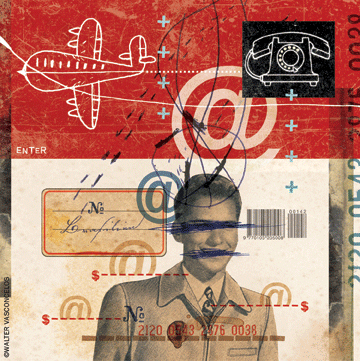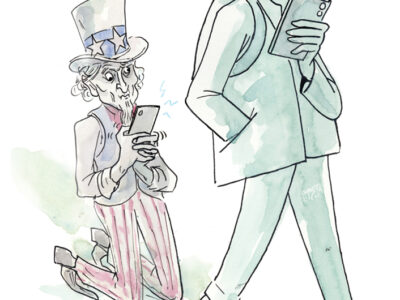
Today’s consumers feel spied on and manipulated—and powerless to stop it.
By Joseph Turow
A couple of years ago, in an undergraduate seminar I taught called “Spam and Society,” discussion veered a bit off topic. One of the students asserted confidently that airline websites give first-time users lower prices than returning customers. Most of the others immediately agreed. They said the motive was to suck in potential buyers; then, when they returned, the airline could quietly raise prices.
I hear this kind of claim fairly often among heavy computer users. It seems to have become an article of faith that the unseen moguls behind all sorts of websites are cherry-picking consumers, customizing ads, manipulating prices, and changing product offers based on what they’ve learned about individual users without the users’ knowledge.
In my research on Internet marketing, I talk to lots of web workers and consultants, and read the trade press, and it’s pretty clear that this is going on. But it’s extraordinarily hard to verify when it occurs, why any particular offer is made, or how a vendor is evaluating any given customer. Online merchants don’t have to tell anyone how they operate, so generally they don’t.
I’m disturbed by what this reflects about our general retail environment—the evolution of what I would call a culture of suspicion. From airlines to supermarkets, from banks to websites, American consumers increasingly believe they are being spied on and manipulated. But they continue to trade in the marketplace because they feel powerless to do anything about it.
This is a profound change. Broadly speaking, the past 150 years saw what you might call the democratization of shopping in the United States. Beginning around the mid-1800s, department stores such as Stewart’s in New York City and Wanamaker’s in Philadelphia moved away from the haggling mode of selling and began to display goods and uniform prices for all to see. Part of the motive was self-interest: Given the wide variety of merchandise and the large number of employees, the store owners didn’t trust their clerks to bargain well with customers. But the result was a more or less egalitarian, transparent marketplace—one that Americans have come to take for granted.
This reliance on evenhanded, fair dealing lies at the heart of American capitalism, or at least the way we’d like to think of it. The scaffolding of this system is shaken if a retailer changes its offerings to individual consumers based on information about the consumers that the consumers don’t know, or that they suspect but can’t verify. Take airline tickets. The Consumer Union’s WebWatch investigators visited airline sites many hundreds of times, finding a bewildering array of prices that seemed weirdly random and virtually unpredictable (some prices changed between logon and checkout). The airlines say it’s the result of a necessarily complex pricing structure, but how can we tell that’s all that’s going on?
It’s hard for any dispassionate observer to believe that prices aren’t being manipulated when an August 9 New York Times article describes examples of “fare customization” at major airlines. Though computer programs like Ding at Southwest Airlines are presented as a way to offer customers direct discounts, industry analysts fear that the personal information they collect could be used to predict which fliers are willing to pay higher fares. Even back in 2001, associates from the influential McKinsey consulting firm wrote in a Harvard Business Review article that online companies are missing out on a “big opportunity” if they are not tracking customers and adjusting prices accordingly—either to attract new buyers or get more of their money.
Meanwhile, this sort of thing goes on quite openly in brick-and-mortar retail stores. In a hyper-competitive environment, where trying to beat Wal-Mart and Costco on price is all but impossible, department stores and supermarkets compete with them by trying to hook the right customers. Operating on the financial industry’s premise that about 20 percent of the customers bring in 80 percent of profits, they try to identify who belongs in that 20 percent—who will spend money and come back to spend more.
It happens everywhere. Many banks give customers scores based on their deposits and financial backgrounds; their phone representatives use friendlier scripts for high scorers. Supermarket cash registers spit out customized coupons at checkouts, tailored to the previous purchases recorded on “preferred customer” cards. Some grocery chains are already testing “shopping buddies,” small computers that you actually carry around the store, getting personally tailored recommendations and discounts from the moment you enter.
The idea used to be that you, the consumer, could shop around, compare goods and prices, and make a smart choice. But now the reverse is also true: The vendor looks at its consumer base, gathers information, and decides whether you are worth pleasing, or whether it can profit from your loyalty and habits.
This all might make sense for retailers. But for the rest of us, it can feel like our simple corner store is turning into a Marrakech bazaar—except that the merchant has been reading our diary while we’re negotiating blindfolded, behind a curtain, through a translator.
Certainly, being targeted by marketers has its benefits. I like getting coupons for my favorite breakfast cereal. I like Amazon.com suggesting films I might enjoy. And I like being treated well on the phone by a company that thinks I’m valuable. But I also like feeling that I’m in control of buying the product, not that the seller is choosing me.
It’s hard to be in control when you don’t know what’s going on. A survey I directed this year for the Annenberg Public Policy Center found a startling degree of high-tech ignorance among Americans who use the Internet. Eighty percent of those interviewed knew that companies can track their activities across the Web. Yet a substantial majority also believes that it is illegal for merchants and charities to sell information about them, even though it’s legal and goes on all the time. Sixty-four percent believe incorrectly that “a site such as Expedia or Orbitz that compares prices on different airlines must include the lowest airline prices.” And only 25 percent knew that the following statement was false: “When a website has a privacy policy, it means the site will not share my information with other websites and companies.”
Our report calls for changing the Orwellian label “Privacy policy” to the more honest “Using your information.” We also call for merchants to be more open about the specifics of their database activities.
And without succumbing to paranoia, consumers need to be cautious about how their information may be used. If you don’t want your drugstore building a profile about you based on your hemorrhoid cream or blood-pressure medication, don’t pay for those items with your shopper’s discount card. Dismantle cookies from marketing sites and use anti-adware programs that stop companies from placing software on your computer to monitor what you do online. Comparison-shop on a few sites before buying any tickets; if you’ve been on a site before, you might want to eliminate the site’s cookies from your computer before returning.
But schools and governments must also get involved. Consumer education currently has little visibility in elementary through high school, and media literacy is virtually nonexistent. Not only are the two knowledge areas critical to navigating the 21st century, they are very much interrelated. Computers with commercials and interactive messages are showing up on supermarket shopping carts.
Government actions are critical to establishing an atmosphere of marketplace transparency and trust. We found that 65 percent of respondents disagreed with the statement “I trust the U.S. government to protect consumers from marketers who misuse their information.” To regain that trust, public officials must take strong actions against the exploitation of people’s personal data and for marketplace transparency and education. A well-developed, critically informed understanding of how the new worlds of media and commerce work together can have favorable consequences for the ways people view business, government, and the environments in which they shop.
Dr. Joseph Turow is the Robert Lewis Shayon Professor of Communication at the Annenberg School for Communication and the author of Niche Envy: Marketing Discrimination in the Digital Age, which The MIT Press will publish this year. His report, Open to Exploitation: American Shoppers Online and Offline, is available at www.annenbergpublicpolicycenter.org/. This essay was adapted from a June 19 article by Turow in The Washington Post.




